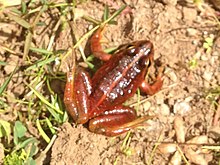| Amietia wittei | |
|---|---|

| |
| Conservation status | |
 Least Concern (IUCN 3.1) | |
| Scientific classification | |
| Domain: | Eukaryota |
| Kingdom: | Animalia |
| Phylum: | Chordata |
| Class: | Amphibia |
| Order: | Anura |
| Family: | Pyxicephalidae |
| Genus: | Amietia |
| Species: | A. wittei |
| Binomial name | |
| Amietia wittei (Angel, 1924) | |
| Synonyms | |
| |
Amietia wittei (common names: Molo frog, De Witte's river frog) is a species of frog in the family Pyxicephalidae. It is found in Kenya and Tanzania, including Mount Elgon in the Kenya/Uganda border region. Its type locality is in Molo, Kenya, located near the top of the Mau Escarpment. The specific name wittei honours Gaston-François de Witte, a Belgian naturalist.
Description
Adult males reach 55 mm (2.2 in) and adult females 87 mm (3.4 in) in snout–urostyle length. The dorsal ground colour is a dark brown, becoming lighter on the flanks and yellowish on to the belly. The dorsolateral folds are black, and so are many of the elongated warts on the back. A row of irregular dark blotches runs from the groin towards the tympanum. Some specimens have a pale (bright green) vertebral stripe. The upper lip is uniformly dark or marbled; a pale (coppery) band above the upper lip extends between the tympanum and eye, touching the eye. The lower lip is marbled.
Habitat and conservation
Amietia wittei is a locally common species inhabiting montane grasslands at elevations of 1,100–3,300 m (3,600–10,800 ft) above sea level. It is associated with streams and can be found in areas of low-intensity agriculture. It is suffering from some habitat loss and deterioration caused by expanding human settlements, wood collection, and logging. It occurs in several national parks: Aberdare and Mount Kenya National Parks in Kenya, Mount Elgon National Park in Kenya/Uganda, and Kilimanjaro National Park in Tanzania.
References
- ^ IUCN SSC Amphibian Specialist Group (2020). "Amietia wittei". IUCN Red List of Threatened Species. 2020: e.T58191A175798024. doi:10.2305/IUCN.UK.2020-2.RLTS.T58191A175798024.en. Retrieved 15 November 2021.
- ^ Frost, Darrel R. (2018). "Amietia wittei (Angel, 1924)". Amphibian Species of the World: an Online Reference. Version 6.0. American Museum of Natural History. Retrieved 18 May 2018.
- ^ Channing, A.; Dehling, J.M.; Lötters, S. & Ernst, R. (2016). "Species boundaries and taxonomy of the African river frogs (Amphibia: Pyxicephalidae: Amietia)". Zootaxa. 4155 (1): 1–76. doi:10.11646/zootaxa.4155.1.1. PMID 27615865.
- Beolens, Bo; Watkins, Michael & Grayson, Michael (2013). The Eponym Dictionary of Amphibians. Pelagic Publishing. pp. 56, 234. ISBN 978-1-907807-42-8.
| Taxon identifiers | |
|---|---|
| Amietia wittei | |